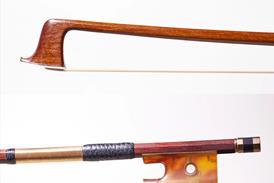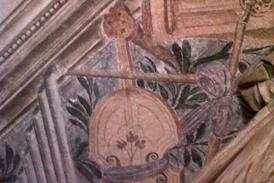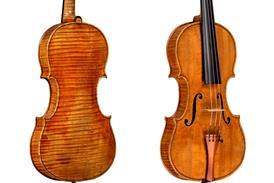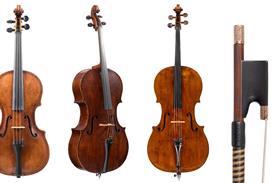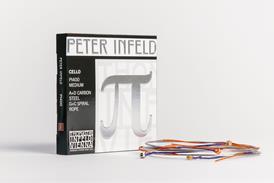All Lutherie articles – Page 38
-

-
 Premium ❘ Feature
Premium ❘ FeatureTrade Secrets: Inlay techniques
Giving a decorative flourish to an instrument can add a personal touch – and be a true test of skill
-
 Premium ❘ Feature
Premium ❘ FeatureMaking Matters: A head for figures
Luthiers such as Jacob Stainer often surmounted their instruments with elaborately carved heads rather than scrolls. Lloyd McCaffery, a professional wood carver, explains how he developed a modern take on an ancient art form
-
 Video
VideoA Far Cry performs Tchaikovsky’s Serenade on Cremonese instruments
Musicians from Boston chamber orchestra A Far Cry perform the first movement from Tchaikovsky’s Serenade for Strings from memory on Cremonese instruments selected from the vault of Reuning & Son
-
 News
NewsObituary: Soroku Murata (1927–2020)
The veteran violin maker and teacher was head of the Tokyo Violin Making School and a respected jury member at international making competitions
-
 Focus
Focus7 tips for carving a scroll
How to perfect the head of your instrument from 125 years of the Strad
-

-
 Video
VideoWhittall Stradivarius Collection
Musicians talk about and demonstrate instruments donated to the Library of Congress by Gertrude Clarke Whittall in 1935. With Robert Mann, Alexis Galperine, Miles Hoffman, Rene Morel, Young Uck Kim, Daniel Phillips, and Samuel Zygmuntowicz.
-
 Focus
FocusMichel Collichon, enigma among French viol makers
Just a handful of instruments by Michel Collichon have survived to the present day – but they demonstrate the skill and techniques of a master innovator. With a tenth example recently identified, Shem Mackey explains the appeal of the 17th-century viol maker to modern-day luthiers
-
 Premium ❘ Feature
Premium ❘ FeatureChinese Tonewoods: Interesting Times
For luthiers worldwide, European wood is still viewed as the best for making stringed instruments – even though China’s forests are filled with high-quality spruce and maple. Xue Peng presents the results of a study comparing the tonewoods of China and Europe, with some startling conclusions
-
 Video
VideoGlass fibre cello used to play Takemitsu
Carbon fibre instruments have been introduced on the market for a couple of years. A research team from Ghent University and School of Arts Gent has been investigating the use of composite materials for string instruments. Now, one of their prototypes, a cello made from glass fibre by luthier Tim ...
-
 Article
ArticleAn almost perfect success story: the evolution of Vuillaume
Jean-Baptiste Vuillaume was the most successful French luthier of his time, but the first years of his career remain shrouded in mystery. Jonathan Marolle examines some of his earliest instruments to uncover the evolution of his technique and style
-
 Focus
FocusWhat do violinists Sarah Chang and Hilary Hahn keep in their instrument cases?
Ever wondered what players keep in their instrument cases, apart from their Strads? We talk to some well-known performers to discover the secrets they hold
-
 Premium ❘ Feature
Premium ❘ FeatureTrade Secrets: Notes on cello endpin fitting
A guide to veneer bushing and creating an ‘abrasive reamer’ for making adjustments
-

-
 Premium ❘ Feature
Premium ❘ FeatureMaking Matters: The Sound of Science
Tom Croen reports on a 2019 experiment to discover how much variation in sound can be gained from fingerboard ‘tuning’ – and how alternative materials fare against traditional ebony
-
 Premium ❘ Focus
Premium ❘ FocusTrade secrets: bending the slope on a viola da gamba back
Care and accuracy are both essential for this delicate part of the making process. By Gabriela Guadalajara, luthier based in New York, NY, US
-
 Premium ❘ Feature
Premium ❘ FeatureUniversal Harmony: the ‘Four Circles’ system of violin making
Luthiers over the past three centuries have used a vast number of patterns for their instruments – but the basic geometric principles remain constant across them all. Kevin Kelly explains his ‘Four Circles’ system for instrument design, adaptable to violins, violas and cellos
-
 Premium ❘ Feature
Premium ❘ FeatureDigital Amati: project luthier
A decade ago, François Denis’s Traité de Lutherie showed how the old Italians used Euclidean geometry to design their instruments. Now a computer program based on these principles allows luthiers to construct and adapt patterns quickly and easily. Its creator, Harry Mairson, explains the genesis of Digital Amati
-
 Premium ❘ Focus
Premium ❘ FocusTrade secrets: a method for cooking oil varnish by Nicolas Gilles
A technique that relies on the senses and helps you get the right varnish for your needs, by Nicolas Gilles, luthier in Villeneuvette, France





